%20(1).png)
Ballymoney National School

.png)


Green-Schools and Water
-
In Ballymoney National School, the pupils are working towards the Green-Schools flag for the Water theme.

Step 1: Green-Schools Committee
-
Our Green-Schools Committee is made up of 9 pupils ranging in age from 7 to 12 years and from 1st class right up to 6th class.
-
We also have a coordinating teacher on the committee.
-
We all have different roles on the 'Water Squad' such as litter wardens, water wardens and leaky detectives. These roles will be rotated so that everyone gets to experience them all.
-
We meet every Friday afternoon at approx. 2 pm in the junior classroom.
-
The committee promises to make sure all 7 steps of the programme are achieved; take responsibility and share ideas for our water theme; and make sure the views of all pupils in the school are listened to and that actions will be taken where possible.


Step 2: Environmental Review
-
The pupils on the committee undertook 3 essential actions so as to assess the initial situation regarding water in our school.
-
This review helped the committee to decide on the best course of action for improvement within our small school.
Essential Action 1: Calculate your water usage
-
The water meter was read once a week for a number of weeks.
-
The committee was able to get an idea of how much water was used per person per day.
-
Water bills were also examined but it was difficult to get an accurate picture from these due to school closures with holidays and Covid.
-
The pupils also made some manual estimations by keeping tick sheets for 5 days and working out how much water is released from the push taps.





Essential Action 2: Conduct a manual water audit
-
The committee counted the number of taps, toilets, urinals, outdoor taps and kettles. Our school does not have a dishwasher or a washing machine.
-
All of these items were shown on a map of the school.

Essential Action 3: Conduct leak tests
-
Committee members checked for any drips or leaks in the taps and toilets.




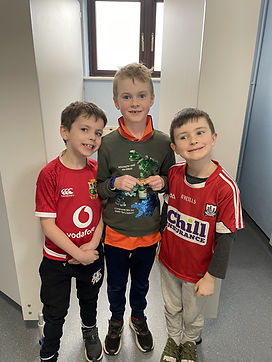

Step 3: Action Plan
The pupils on the committee have decided on a list of targets for our Action Plan. These include:
-
Raise awareness about water conservation
-
Run a water photo competition 'Ways We Use Water'
-
Create a poster of our school's water cycle, showing where our water is sourced, where it is treated and where the waste water goes
-
Conduct a Water Use Survey amongst the pupils in school and analyse results
-
Send home a Behavioural Survey for each family to complete and analyse results
-
Compile a list of detergent and cleaners in the school and try to make Eco-friendly ones
-
Adopt the River Bandon and do a river clean-up over at Riverside Garden
-
Fix our water butt and collect rainwater for our school garden
-
We have 3 dual-flush toilets in the school. We hope to put 500ml bottles into these cisterns and 1L bottles into the boys' toilets so as to save on water with each flush
-
Run a water poster competition
-
We have water-saving taps but one tap in the girls' bathroom needs to have the water flow adjusted
-
Turn off the urinals at the end of the school day and at weekends
-
Learn more about the local water treatment facility
-
Place 'Turn it off' signs over the lever head taps
-
Design a leaflet of tips for saving water
-
Organise a 'Water Action Day'
-
Set up a Green-Schools notice board
-
Place a suggestion box near the notice board so that pupils outside of the committee can post their ideas







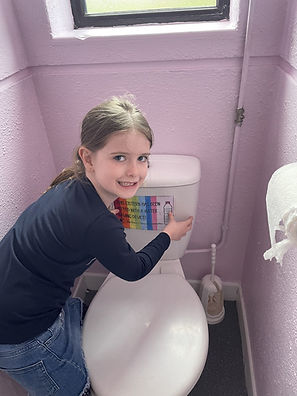
The Green-Schools Committee surveyed the 26 pupils in the school about how they use water in their homes and at school. Here are the results:

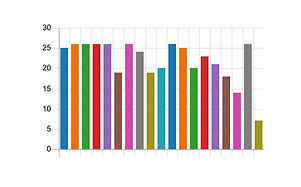

The pupils investigated the water pressure in some of the taps at school. They timed how long it took to fill 1 litre of water. The results are below. There is good water pressure in each of the lever head taps but poor pressure in the push taps.




Here is a picture of the water life cycle of our school. The River Bandon rises at Nowen Hill and makes its way to Dunmanway and onwards from there to the twin villages of Ballineen and Enniskeane. It then flows towards Bandon. The water for our school is treated in the Water Treatment Plant at Baxter's Bridge and it is then stored in the holding tank in Ballineen. From there it is pressurised and sent off in different directions to the homes and businesses in Ballineen. When we use water in our school, the waste water is then dealt with in the septic tank on site at the school.

The Green-Schools Committee asked all pupils and their families to fill in a Water Use Survey in year 1. This allowed the Committee to gauge awareness of water usage and conservation among both groups. Here is a sample of the questions asked:


We have two water butts in our school. They collect rainwater from the gutters and the pupils then use this water for the school garden.




World Water Day 2023 is on Wednesday 22nd March.
We want to raise awareness about water scarcity in developing countries. Did you know that women and children in countries around the world have to walk on average 6km a day to access water which is often not clean or sometimes not even there due to drought. This is not safe and causes different kinds of sicknesses.
The pupils at Ballymoney National School are working towards their Green-Schools flag for water and they have been learning about water usage and conservation. Let’s be the change you want to see in the world.
Today, on 27th February, the pupils carried 171 litres of water in their bags and in their hands and went on a 1km walk. This was to let them experience what it’s like to walk and carry this essential resource. All of this water was taken from our water butts and returned afterwards so that we can use it in our school garden. Afterwards the pupils enjoyed some orange slices. Well done everyone!

The pupils took a look at the cleaning products in the locked cupboard. They found surface cleaners, bleach, wood cleaner, window cleaner and bathroom cleaner. They hope to make some eco-friendly ones that can be used instead. Below is a photo of the pupils using their own 'home-made' window cleaner.

The local Tidy Towns Association organised a water workshop for our school. The pupils assessed the water quality of the River Bandon and their data gave it a 4.8 out of 5 rating for water quality. They observed lots of aquatic insects as well as a kingfisher and a heron. They didn't spot any litter or pollution.

We have learned about Global Goal 6 which is all about the right for everyone to have access to 'Clean Water and Sanitation'. We have been working so hard on ways that we can support this goal. Here is our entry for the poster competition which we are still working on.

We have also been looking at aquatic wildlife and have been observing some frogspawn in school. We will return the little froglets to their native habitat when the time comes.

Almost two years ago, we made this bottle top mural from 12,400 bottle tops. It depicts the twin villages of Ballineen and Enniskeane, the River Bandon, Ballineen Bridge and the native wildlife that we can see from our school including some swans and a heron. We got a lot of publicity for our creation and we are extremely proud of ourselves for making this massive piece of art from plastic bottle tops.

Step 4: Monitoring and Evaluation
-
Here are our water readings over similar time periods in Year 1 and Year 2. You will see that for the most part we have managed to reduce our amount of litres used per person per day.

We report any problems encountered in both the boys and girls' bathrooms by recording the event with a date, problem observed and action taken. The pupils are awarded a sticker each day for looking after their bathrooms. They are also involved with the Picker Pals and take home the kit to go litter picking with their families. We also have signs on our bins to remind us of what is acceptable in the recycling and general rubbish bins. The pupils and staff check through the bins to ensure everything is in the right place.

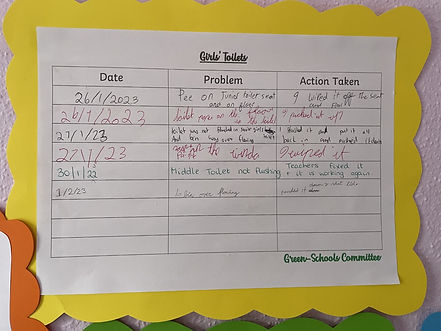
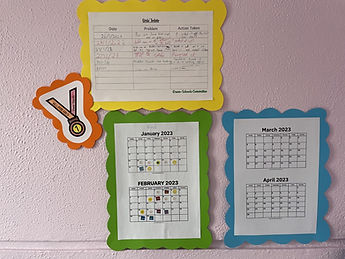

Step 5: Curriculum Work
Press play on the videos below to see some experiments based on the theme of water.
The pupils investigated what happens to toilet paper, paper towel and wipes when you put them in water. They discovered that when shook the toilet paper breaks up, the paper towel stays intact and soaks up the water and the wipe stays as it is. They learnt that it's very important to only put toilet paper into the toilet.




There are 11 Blue Flag Beaches in Cork. The nearest to us is Inchydoney East Beach and Inchydoney West Beach. Others include Garretstown, Owenahincha and Tragumna. Last year, we visited Inchydoney for a ukulele concert.



Step 6: Informing and Involving
We use many ways to tell everyone about what we are doing. As well as having this sub-page on our website, we also have an active presence on social media: a Facebook page, an Instagram grid and a Twitter account. We include relevant information about Green-Schools in school newsletters as the need arises and we have a Green-Schools notice board in the corridor in school. The committee asked all pupils and their families to fill in a survey relating to their water usage in the home and in school. We also put out a request to parents to send in clean 2-litre milk cartons for our 'Walk for Water'.


Step 7: Green Code


Green Schools


















































